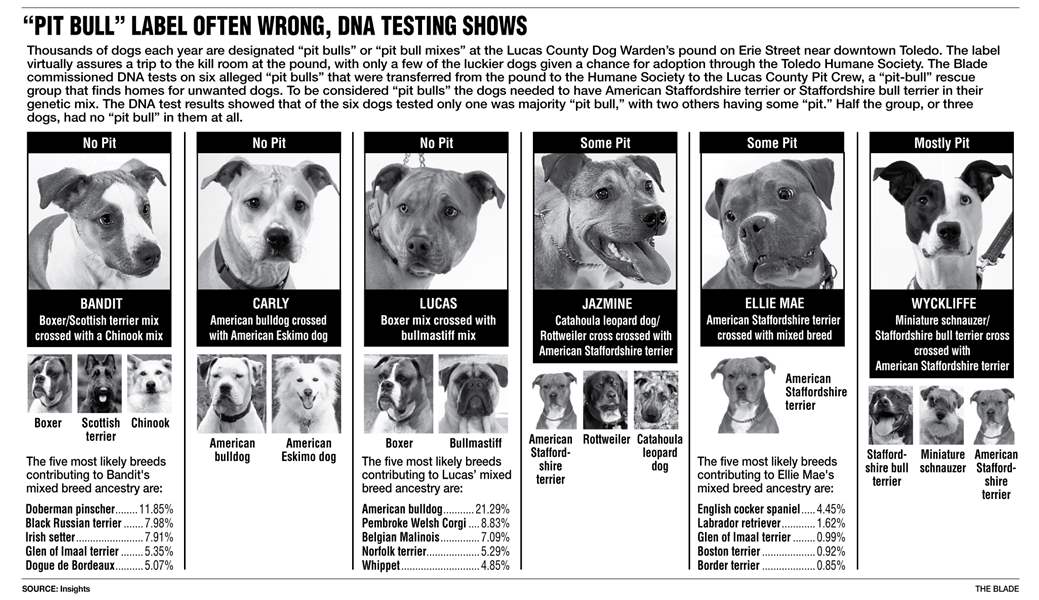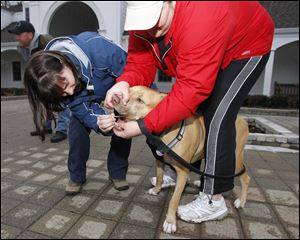
MISTAKEN IDENTITY
Many shelter dogs mislabeled ‘pit bulls’
DNA analysis shows guesses often subjective
3/18/2012
The Blade
Buy This Image

Jean Keating of the Lucas County Pit Crew swabs the mouth of Lucas while his owner, Laurie Hughes of Rossford, holds him. Testing found no 'pit bull' in Lucas.
Lucas is lucky to be alive.
The dog, owned by Laurie and George Hughes of Rossford, was one of the first "pit bull" puppies spared by the Lucas County dog warden in January, 2010, after the county commissioners changed a long-standing policy under which all "pit bulls," no matter their age or temperament, were automatically destroyed.
The irony is that Lucas, who was transferred to the Toledo Area Humane Society, isn't a "pit bull."
According to a DNA test, Lucas is predominantly a boxer/bullmastiff mix, with a few other mixed breeds thrown in. But the dog doesn't have any American Staffordshire terrier or Staffordshire bull terrier in his lineage, according to a Mars Veterinary Wisdom Panel Insights DNA test.
"We really don't care what breed he is, he's a good dog and we love him," said Mr. Hughes, who with his wife adopted Lucas from the humane society. "I think it's awful what people say about 'pit bulls' or dogs that look like 'pit bulls.' It's like racism, except against dogs."
RELATED ARTICLE: Ex-dog warden stands by action on 'pit bulls'
Lucas isn't alone. Many dogs are mislabeled as "pit bulls" because they might have a certain look -- such as a large head or broad chest.
The Blade purchased the DNA-gathering kits from the Mars Veterinary company and conducted the tests on six dogs that were originally labeled as "pit bulls" by the Lucas County dog warden.
The test consists of two swabs with wire bristles that are scraped on the inside of the dog's cheek to remove skin cells. The swabs were placed in protective plastic casings and mailed to the laboratory for analysis, which took three to four weeks.
Only one of the six tested dogs was predominantly American Staffordshire terrier and Staffordshire bull terrier, the two recognized breeds labeled as "pit bulls." Two others had some "pit," and three dogs had no "pit bull" breed in them at all.
Besides Lucas, which had no "pit" breed in his genetic makeup, there were two other dogs with no "pit":
Carly: American bulldog and American Eskimo dog.
Bandit: Boxer, Scottish terrier, Chinook, Doberman pinscher, black Russian terrier, Irish setter, Glen of Imaal terrier, and dogue de Bordeaux.
Two of the dogs had some "pit" in them:
Ellie Mae: American Staffordshire terrier, English cocker spaniel, Labrador retriever, Glen of Imaal terrier, Boston terrier, and border terrier.
Jazmine: Catahoula leopard dog, Rottweiler, and American Staffordshire terrier.
Only one of the six dogs' DNA tested by The Blade was majority "pit bull":
Wyckliffe: Miniature schnauzer, Staffordshire bull terrier, and American Staffordshire terrier.

Labeling canines
Determining a dog's breed can be subjective. Yet that can determine whether a dog lives or dies in Toledo and Lucas County.
The concept has been researched before. Dr. Victoria Voith and colleagues from Western University of Health Sciences in Pomona, Calif., surveyed animal adoption agency personnel, asking them to name the breed or breeds of mixed-breed dogs whose origins they did not know and then compared their guesses to DNA analysis of the same dogs.
Her work concluded that there is little correlation between dog adoption agencies' identification of probable breed composition with the identification of breeds by DNA analysis.
Former Lucas County Dog Warden Tom Skeldon said that when he was in the position two years ago, he didn't think the DNA tests were accurate.
"When I left the field, the DNA situation was something that was being put up by 'pit bull' advocates to show that you couldn't prove and animal was a 'pit bull,' " he said. "There's a couple of flaws in that. 'Pit bulls' aren't a breed, they're a type. So you are trying to find genetic evidence of a type as opposed to a breed. We won those cases in court."
Dr. Angela Hughes, a veterinarian and the veterinary genetics research manager at Mars Veterinary, said the reliability of the tests the company sells has increased over the past four years. Currently the swab-based DNA test has an accuracy rating of 80 to 85 percent, depending on how good a sample is provided.
Dr. Hughes checked the samples that The Blade had submitted. The swabs had collected a good amount of DNA, which drives up the reliability of the tests, she said. With samples that don't have as much DNA to work with, results may contain a breed that isn't in the dog or may miss breed, but the entire test is not wrong.
Killing continues
Mr. Skeldon, forced into retirement in part because of the furor over his high kill rate and his insistence that all dogs he deemed "pit bulls" must be killed, remains unrepentant about killing "pit bulls."
As warden he killed "pit bulls" even if they were gentle dogs that could have been adopted. He also insisted on killing all puppies he deemed to be "pit bulls."
It's impossible to know how many dogs Mr. Skeldon killed claiming they were "pit bulls" when they weren't, but based on the kill rate during his more than 20 years as warden, the fact that close to half the dogs at the pound traditionally have been labeled "pit bulls," and the DNA tests The Blade performed, easily thousands of dogs could have been killed because they were mislabeled "pit bull."
Mr. Skeldon stands by his visual observations, saying 98 percent of the dogs he deemed to be "pit bulls" were that and deserved to die to protect the public.
The Lucas County dog warden's office continues to kill dogs because it is "at capacity for 'pit bull-type' dogs." Dog Warden Julie Lyle has yet to begin adopting out "pit bulls" directly to the public instead relying on the Toledo Area Humane Society and rescue groups such as the Lucas County Pit Crew to take them.
At issue has been the state's dangerous dog law, which until it officially changes May 21, still labels all "pit bulls" as dangerous, vicious dogs, despite their actual behavior. Ms. Lyle will not adopt out "pit bull"-type dogs as long as they are considered vicious.
However, the humane society has adopted out nonvicious "pit bulls" since April, 2010, directly adopting out 79 itself while sending 75 on to rescues such as the Lucas County Pit Crew.
'Shelter dogs'
As a way to combat the issue, Dr. Amy Marder, director for the Center for Shelter Dogs, has proposed that dogs adopted from shelters in the United States simply be identified as "American shelter dogs."
Jean Keating, co-founder of the Lucas County Pit Crew, a rescue group that supports responsible guardians of "pit bull"-type dogs through education, advocacy, training assistance, spay/neuter promotion, and adoption, agrees with that approach.
"When it comes down to deciding issues of life and death, if we are basing that on a decision about appearance, then we are really going down the wrong path," Ms. Keating said. "If breed experts are telling us that they are not comfortable identifying mixed breeds, then why do any of us think we can do it?"
Identifying breeds
One shelter, the North Shore Animal League in Port Washington, N.Y., has done away with the label "pit bull," instead referring to dogs with that look as "terrier mixes," because all of the breeds commonly given the "pit bull" moniker are in the terrier group.
Ms. Lyle, who identifies 40 percent of the dogs the pound takes in as "pit bulls," said she has a problem with that approach because she thinks it is deceptive to the public.
"When people think of terriers, they think of small, cuddly dogs, not large dogs," Ms. Lyle said.
She said that besides herself, others in the facility such as the deputy dog wardens or the office staff, are the ones who designate the breeds of dogs that are impounded. Owners are asked to identify the breed of a dog they are surrendering, and the pound usually defers to them, unless the breed they name is obviously incorrect.
"Puppies are a lot harder to determine," she said. Two of the dogs The Blade conducted DNA tests on were puppies when they were identified as "pit bulls" by the dog warden's office.
Ms. Lyle said she thought she and her coworkers had done pretty well in guessing the breeds of dogs they designated as "pit bills" but was not surprised that they had gotten some wrong. She said she doesn't see any reason for the pound to change how it identifies a dog's breed.
Two of the dogs tested were under a year old when the pound labeled them "pit bulls."
Ms. Lyle said guessing the breed of a puppy is a lot more difficult than that of an adult dog. As for the adults she got wrong, she stood by her original assessment, but acknowledged that guessing breeds is very subjective. "We do the best we can," she said. "And we're not afraid to ask for a second opinion [of another staff member] if we are not sure."
The Toledo Area Humane Society defers to the dog warden on naming the breeds of dogs that are transferred to the shelter from the pound -- including 91 "pit bulls" in 2011. "If we change the breed designation they put on a dog either from or to 'pit bull,' we make sure that is OK with [the dog warden,]" said John Dinon, executive director of the humane society.
The humane society has discussed changing how it labels dogs, he said. "We have discussed this, not so much in the context of 'pit bulls' but just to make sure we are not misrepresenting," he said. "For example, if we call something a Lab mix, we don't want an adopter to be disappointed if it ends up not loving water."
One suggestion that was made was calling all dogs at the shelter "American" mixes.
"I think we are going to continue to use breed and breed mix labels but tell adopters that breed designations are based on our assessment of physical appearance and reports from previous owners only," Mr. Dinon said.
The humane society is aware of the need to educate the public about "pit bull" facts and fallacies, he said. The feature article in the humane society's next newsletter will focus on "pit bulls."
The story is about the law change and also about how the new law does not address some "pit bull issues" such as overpopulation, the fact that some criminals use them for intimidation, which can lead to stigma, that they are the dogs that are most often victims of cruelty, and that they are the preferred dogs of dog fighters.
"We certainly have been advocates to judge dogs by behavior and not breed, and our education programs include some breed identification games, to show people how often they are wrong," Mr. Dinon said.
Contact Tanya Irwin at: tirwin@theblade.com or 419-724-6066.